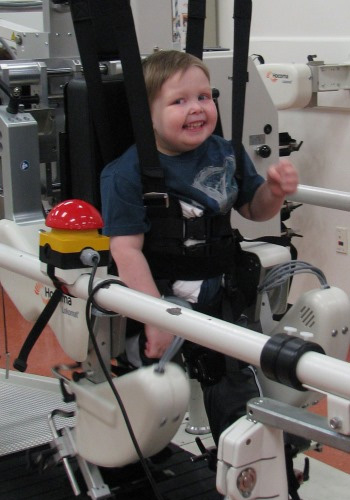 In February 2008, Tina Bailey scheduled an office visit with her son’s pediatrician when he developed croup and a bad cough. While at the doctor’s office, 22-month-old Scottie exhibited right hand curling and right shoulder drop.
In February 2008, Tina Bailey scheduled an office visit with her son’s pediatrician when he developed croup and a bad cough. While at the doctor’s office, 22-month-old Scottie exhibited right hand curling and right shoulder drop.
“In hindsight, the signs were there a couple of months earlier,” Bailey says. “Scottie started tripping frequently and developed a limp, but we couldn’t find anything wrong and the limp improved.”
Bailey’s pediatrician ordered an MRI, which revealed a large tumor located in the mid-brain and brainstem. Following a stereotactic biopsy, Scottie was diagnosed with glioblastoma multiforme (GBM), the most common and most aggressive malignant primary brain tumor seen in humans.
The median survival after a diagnosis of GBM is 14 months. Because of its location, the tumor was inoperable, and Scottie was treated with standard-of-care radiation therapy and chemotherapy.
“As the cancer cells died, he developed hydrocephalus in the third ventricle,” Bailey says. “The buildup of fluid inside his skull caused his brain to swell, which led to more neurological symptoms.” He underwent a third ventriculostomy to drain the excess cerebrospinal fluid from the brain.
“The odds were really stacked against Scottie, but the tumor didn’t grow back, which is completely amazing,” she says. “We consider ourselves extremely blessed.”
The tumor and treatment left Scottie with motor deficits. He could roll in bed but needed moderate assistance to move from one surface to another and maximal assistance to stand and walk. When he came to TIRR Memorial Hermann Pediatric Rehabilitation at the Kirby Glen Center in June 2011, he could walk only 10 feet with assistance.
Bailey requested the referral to TIRR Memorial Hermann after reading about the Lokomat®, a robotic-assisted treadmill that features body-weight support. The robot wraps around the user’s legs and puts them through the walking motion at a comfortable pace on a treadmill.
“From the beginning, our primary goal with Scottie was increasing his independence with the least amount of support,” says Laura Martin, PT, DPT, NCS.
“To accomplish that objective, we started him walking on a treadmill suspended by a harness to get him used to walking with support before transitioning him to the Lokomat. In the first couple of weeks, his buy-in to therapy improved, as did his strength. Over the following weeks, we continued to build his tolerance for walking with the Lokomat to a maximum of 40 minutes. We’re now working toward transitioning from the walker to crutches, and we’re also focused on improving transitional movement – getting up and down from the floor and climbing into chairs. Being able to get in and out of a wheelchair was a big learning moment for Scottie.”
Today, at the age of 7, Scottie can squat, reach, throw beanbags without support and walk more than 100 feet using a walker. Martin attributes Scottie’s success to the support of his parents and his own attitude.
“Raising a family is a fulltime job,” she says. “Still, they take the time to drive from their home in Cypress through Houston traffic multiple times a week for therapy appointments. Therapy is demanding and time consuming. In addition to our sessions with Scottie, they do a lot of continuing work with him at home. They’ve been very conscious of putting him in situations where he can grow stronger.”
“It’s been an awesome experience for all of us,” Bailey says. “You can tell that therapy is more than a job for the staff. They’re not just going through the motions. Everyone is very enthusiastic and creative in working with him, and Laura is very, very knowledgeable. As a result, his improvement has been dramatic. I can hand him his walker, and he can walk into the house without my help. He couldn’t do that a year and a half ago. I know he’s in good hands.”

Nationally Ranked Rehabilitation
For the 36th consecutive year, TIRR Memorial Hermann is recognized as the best rehabilitation hospital in Texas and No. 2 in the nation according to U.S. News and World Report's "Best Rehabilitation Hospitals" in America.
Learn more about TIRR Memorial Hermann rankings